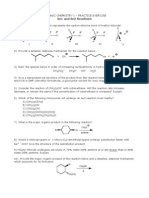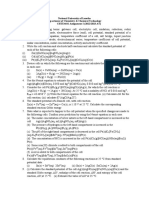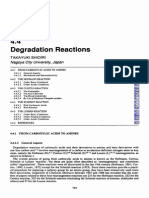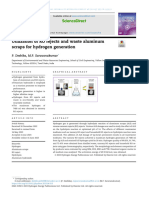Organic Chemistry Questions 3
Organic Chemistry Questions 3
Uploaded by
Ram KrishnaCopyright:
Available Formats
Organic Chemistry Questions 3
Organic Chemistry Questions 3
Uploaded by
Ram KrishnaCopyright
Available Formats
Share this document
Did you find this document useful?
Is this content inappropriate?
Copyright:
Available Formats
Organic Chemistry Questions 3
Organic Chemistry Questions 3
Uploaded by
Ram KrishnaCopyright:
Available Formats
CHEM 281 Prectice for Final Exam
Spring semester XXXX Instructor: Dr. Peggy Paduraru
Student Signature
Please, READ THE QUESTIONS COMPLETELY AND CAREFULLY Clearly mark the answers in the multiple choice sets:
or
Your exam consists of 12
printed pages including this one. The final page of this exam includes a bonus question and you are permitted to use molecular models.
Question 1 (18) 2 (16) 3 (4) 4 (10) 5 (19) 6 (3) 7 (12) 8 (8) 9 (10) Total (100) 1 1 1 1 1 1 1 1 1
Mark 1 1 1 1 1 1 1 1 1 1
10 (5) - BONUS 1 Total
Spring XXXX Final Exam
CHEM 281
Page
1. Clearly indicate the right answer for the following multiple choice questions (A to I). (2 marks
each)
A. What is the activation energy for the reaction B ? A in the following diagram?
B. Which one of the following alkyl halides undergoes E1 reactions with the fastest rate?
CH3CHCH3
F
CH3CHCH3
Cl
CH3CHCH3
Br
CH3CHCH3
I
CH3I
C. Which of the following is the best method for preparing CH3Br?
CH3OH + Br CH3OH + HBr
CH3OH + Br2 CH3OH + NaBr
CH3OH + Br+
D. Which of the following is the most stable cation?
CH3 H3CC CH2 H3C C CH3 CH3 C CH3
CH3
E. What is the name of the major organic product of the following reaction?
CH2=CHC(CH3)3 3,3-dimethyl-1-butanol 2,3-dimethyl-1-butanol H+, H2O 2,3-dimethyl-2-butanol
3,3-dimethyl-2-butanol 4-methyl-2-pentanol
F. Which of the following is not a nucleophile?
Br
FeBr3
NH3
CH3 OCH3
Spring XXXX Final Exam
CHEM 281
Page
G. Which of the following is the best nucleophile in water?
CH3SCH3
CH3OCH3
Cl
Br
H. How many proton NMR single ts will 2-bromo-3-methyl-2-butene exhibit?
G. What are the major products from the following reaction?
O H2 C
HI
I
+
CH2OH
OH
+
CH2I
OCH2I
+
OH
I
+
OCH2OH
H. Which of the following is the best reaction sequence to use if one wants to accomplish a Markovnikov addition of water to an alkene with minimal skeletal rearrangement?
water + dilute acid water + concentrated acid
oxymercuration-reduction hydroboration-oxidation
I. Which of the following statements about propene, CH3CH=CH2 is correct?
all nine atoms lie in the same plane the compound has a cis and a trans isomer all the atoms are sp2 hybridized
it generally acts as a Lewis acid there is a total of eight sigma bonds
Spring XXXX Final Exam
CHEM 281
Page
2. Predict the major products of the following reactions. Include stereochemistry where appropriate. (2 marks each)
(a)
HCl
(b)
Br 2 CCl4
(c)
1. BH3, THF 2. H2O2, -OH
Br2 (d) CH3OH
(e)
H2 Pt
PhCO3H (f)
(g)
H 2O H+
(h)
1. Hg(OAc) 2, H 2O 2. NaBH 4
Spring XXXX Final Exam
CHEM 281
Page
3. Provide a detailed, step-by-step mechanism for the reaction shown below. (4 marks)
Br HO Br2 O + HBr
4. Consider the reaction shown below.
CH2CH 3 Cl
NaOCH2CH3 CH3CH2OH
CH 3
H 3C
CH3
a) Will it proceed by substitution of elimination? What factors determine the most likely mechanism? (2 marks)
Spring XXXX Final Exam
CHEM 281
Page
b) Give the systematic name for the starting material (A). (3 marks)
Name: c) Draw two stereoisomers of compound A and specify their relationship to compound A. (2
marks)
Stereoisomer 1
Stereoisomer 2
d) Write the expected product and the mechanism by which it forms. (3 marks)
Spring XXXX Final Exam
CHEM 281
Page
5. For the following questions (a to e) consider the scheme below as well as the additional facts.
OH A H2SO4 heat HCl H2 O B + C
Facts: - the 1 H NMR of compounds B and C is provided below: B: C: 1.01 (d, 6H), 1.71 (d, 3H), 1.87 (m, 1H), 1.92 (m, 2H), 5.48 (m, 1H), 5.52 (m, 1H) 1.06 (t, 3H), 1.11 (d, 6H), 2.0 (m, 2H), 2.52 (m, 1H), 5.47 (m, 1H), 5.50 (m, 1H) - compounds A and E are constitutional isomers a. Identify structures B to E in the boxes below. (6 marks: 1.5 marks each)
B C
b. Draw two stereoisomers of compound B and name one of them. (2 marks)
stereoisomer 1 stereoisomer 2
Name
Spring XXXX Final Exam
CHEM 281
Page
c. Write a detailed mechanism to account for the transformation below: (4 marks)
H2O
d. Draw a reaction coordinate diagram for the transformation above (D E). Please label transition state(s) as TS, the rate determining step as RDS and indicate what intermediates (if any) are involved. Also, on the diagram indicate G and G0. (4 marks)
Energy
Progress of reaction
Spring XXXX Final Exam
CHEM 281
Page
e. Starting with compound C identified from the scheme above, synthesize 3 alcohols which are structural isomers. (Fill in the structure of compound C, the three reaction conditions and the structure of the three alcohols) (3 marks)
6. Rank the following compounds according to their acidity (3 marks)
HO H3C A B CH3 CH3 CH3 C D OH CO 2H
Most Acidic
Least acidic
Spring XXXX Final Exam
CHEM 281
Page
10
7. In the box above each reaction arrow, please fill in the reagents that would be required to effect the desired transformation. (12 marks: 2 marks each box)
a) OH
b)
c) OH
d) Br
8. Please provide the necessary reagents and conditions to effect the following transformations (more than one step is necessary for each transformation). (8 marks)
O H
a)
Br
b)
HC
CH
Spring XXXX Final Exam
CHEM 281
Page
11
9. Answer the following questions considering the structures A, B and C below.
OCH3 O OH OCH3 OH
A
A B
B
and A C
a) Show the reagents/conditions for the transformations. (4 marks)
b) Is an equimolar mixture of B and C chiral? (circle the one that applies) (2 marks)
YES
c) Draw the enantiomer or compound A. (2 marks)
NO
Spring XXXX Final Exam
CHEM 281
Page
12
d) Compare the boiling points of compounds A and C? Explain (2 marks)
10. BONUS QUESTION (5 marks) How would you accomplish the following transformation (more than one step might be necessary).
Br
Br
You might also like
- OCR - Chemistry - Module 5 Part 1 - GraspIT ANSWERS - A LevelNo ratings yetOCR - Chemistry - Module 5 Part 1 - GraspIT ANSWERS - A Level10 pages
- Nomenclature of Polyfunctional Organic Compounds100% (2)Nomenclature of Polyfunctional Organic Compounds6 pages
- 1 - Introduction - Petrochemical EngineeringNo ratings yet1 - Introduction - Petrochemical Engineering32 pages
- Writing An Organic Chemistry Filename: Writing An Organic Chemistry Lab ReportNo ratings yetWriting An Organic Chemistry Filename: Writing An Organic Chemistry Lab Report6 pages
- 2015 JC 2 H2 Hydroxyl Tutorial (Teachers)No ratings yet2015 JC 2 H2 Hydroxyl Tutorial (Teachers)21 pages
- The Coordination Number and Oxidation State ofNo ratings yetThe Coordination Number and Oxidation State of24 pages
- Alkanes, Alkenes, Alkynes and Their Alicyclic Couterparts: 1. What Is The IUPAC Name For CH100% (1)Alkanes, Alkenes, Alkynes and Their Alicyclic Couterparts: 1. What Is The IUPAC Name For CH17 pages
- CHEM1280 2012 13 Midterm Exam Solution PDFNo ratings yetCHEM1280 2012 13 Midterm Exam Solution PDF5 pages
- Organic Chemistry Reaction Mechanism Group Assignment0% (1)Organic Chemistry Reaction Mechanism Group Assignment3 pages
- MCQ Chapter 9 Haloalkanes and HaloarenesNo ratings yetMCQ Chapter 9 Haloalkanes and Haloarenes2 pages
- Preparation of The Paramagnetic Complex MNNo ratings yetPreparation of The Paramagnetic Complex MN6 pages
- 18 - Kesetimbangan Fasa Dalam Kimia Fisika - Ch.4No ratings yet18 - Kesetimbangan Fasa Dalam Kimia Fisika - Ch.413 pages
- Question Bank - Sem - III - TYBSC Chemistry Paper - II (Inorganic Chemistry)No ratings yetQuestion Bank - Sem - III - TYBSC Chemistry Paper - II (Inorganic Chemistry)8 pages
- Instructions:: Part-A I. Answer ALL The Questions (Each Question Carries One Mark) 10x1 10No ratings yetInstructions:: Part-A I. Answer ALL The Questions (Each Question Carries One Mark) 10x1 103 pages
- Chapter 1 - Introduction To Organic ChemistryNo ratings yetChapter 1 - Introduction To Organic Chemistry102 pages
- Introduction To Organic Chemistry-Good NotesNo ratings yetIntroduction To Organic Chemistry-Good Notes55 pages
- Amines Via Hofmann, Curtius, Schmidt, and Lossen - Comprehensive Organic Synthesis PDF100% (1)Amines Via Hofmann, Curtius, Schmidt, and Lossen - Comprehensive Organic Synthesis PDF34 pages
- Production of Isopropanol: B.Sc. VI Sem Industrial ChemistryNo ratings yetProduction of Isopropanol: B.Sc. VI Sem Industrial Chemistry7 pages
- Aldehydes and Ketones-03 - Assignments (New)No ratings yetAldehydes and Ketones-03 - Assignments (New)26 pages
- Isolasi Dan Karakterisasi Kolagen Dari Kulit IKAN PATIN (Pangasius SP.)No ratings yetIsolasi Dan Karakterisasi Kolagen Dari Kulit IKAN PATIN (Pangasius SP.)18 pages
- Chemical Resistance Data: Environmental Resistance Table: E-Excellent, G-Good, L-Limited, U-UnsatisfactoryNo ratings yetChemical Resistance Data: Environmental Resistance Table: E-Excellent, G-Good, L-Limited, U-Unsatisfactory2 pages
- Advances in The Baylis-Hillman Reaction-AssistedNo ratings yetAdvances in The Baylis-Hillman Reaction-Assisted64 pages
- OCR - Chemistry - Module 5 Part 1 - GraspIT ANSWERS - A LevelOCR - Chemistry - Module 5 Part 1 - GraspIT ANSWERS - A Level
- PMR Spectroscopy: Solved Problems Volume : IIFrom EverandPMR Spectroscopy: Solved Problems Volume : II
- Writing An Organic Chemistry Filename: Writing An Organic Chemistry Lab ReportWriting An Organic Chemistry Filename: Writing An Organic Chemistry Lab Report
- Alkanes, Alkenes, Alkynes and Their Alicyclic Couterparts: 1. What Is The IUPAC Name For CHAlkanes, Alkenes, Alkynes and Their Alicyclic Couterparts: 1. What Is The IUPAC Name For CH
- Organic Chemistry Reaction Mechanism Group AssignmentOrganic Chemistry Reaction Mechanism Group Assignment
- Question Bank - Sem - III - TYBSC Chemistry Paper - II (Inorganic Chemistry)Question Bank - Sem - III - TYBSC Chemistry Paper - II (Inorganic Chemistry)
- Instructions:: Part-A I. Answer ALL The Questions (Each Question Carries One Mark) 10x1 10Instructions:: Part-A I. Answer ALL The Questions (Each Question Carries One Mark) 10x1 10
- Amines Via Hofmann, Curtius, Schmidt, and Lossen - Comprehensive Organic Synthesis PDFAmines Via Hofmann, Curtius, Schmidt, and Lossen - Comprehensive Organic Synthesis PDF
- Topical Guidebook For GCE O Level Biology 2 Part 3From EverandTopical Guidebook For GCE O Level Biology 2 Part 3
- Production of Isopropanol: B.Sc. VI Sem Industrial ChemistryProduction of Isopropanol: B.Sc. VI Sem Industrial Chemistry
- Isolasi Dan Karakterisasi Kolagen Dari Kulit IKAN PATIN (Pangasius SP.)Isolasi Dan Karakterisasi Kolagen Dari Kulit IKAN PATIN (Pangasius SP.)
- Chemical Resistance Data: Environmental Resistance Table: E-Excellent, G-Good, L-Limited, U-UnsatisfactoryChemical Resistance Data: Environmental Resistance Table: E-Excellent, G-Good, L-Limited, U-Unsatisfactory

























































































